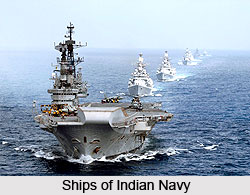 Joint Exercises between the Indian and United States Navies generically referred to as the `MALABAR` series were institutionalised and began in 1992. Indo-US naval cooperation in association with Indian Navy thus commenced with one destroyer (a small fast lightly armoured but heavily armed warship) and one frigate (a United States warship larger than a destroyer and smaller than a cruiser) participating from both sides. From that time, four more MALABAR exercises have been held in 1995, 1996, 2002 and 2003. After May 1998 nuclear tests, there was an interruption in the exercises. The level of participation and complexity of exercises have increased step by step, with the US Navy fielding a nuclear powered submarine, Long Range Maritime Patrol Aircraft (LRMP) (P3C Orion), missile cruiser, destroyers and a tanker in MALABAR 2003. The Indian participation in 2003 was similar in composition, excluding that the country`s submarine was a conventionally powered one. Both sides have been able to better technological and professional standards by taking advantage of respective experiences of operations and training. Procedures for interoperability have also been worked out and practiced. It can thus be clearly comprehended that Indo-US naval cooperation has today become a booming exercise regimen in the Indian Ocean.
Joint Exercises between the Indian and United States Navies generically referred to as the `MALABAR` series were institutionalised and began in 1992. Indo-US naval cooperation in association with Indian Navy thus commenced with one destroyer (a small fast lightly armoured but heavily armed warship) and one frigate (a United States warship larger than a destroyer and smaller than a cruiser) participating from both sides. From that time, four more MALABAR exercises have been held in 1995, 1996, 2002 and 2003. After May 1998 nuclear tests, there was an interruption in the exercises. The level of participation and complexity of exercises have increased step by step, with the US Navy fielding a nuclear powered submarine, Long Range Maritime Patrol Aircraft (LRMP) (P3C Orion), missile cruiser, destroyers and a tanker in MALABAR 2003. The Indian participation in 2003 was similar in composition, excluding that the country`s submarine was a conventionally powered one. Both sides have been able to better technological and professional standards by taking advantage of respective experiences of operations and training. Procedures for interoperability have also been worked out and practiced. It can thus be clearly comprehended that Indo-US naval cooperation has today become a booming exercise regimen in the Indian Ocean.
When the Indian government is concerned with far-reaching prospects in the novel Indo-US naval cooperation, there already has occurred interactions with the US Navy in other exercises. SAREX is the generic name of a multilateral Search and Rescue Exercise which includes forces from the US Navy, the Indian Navy (IN) and the Indian Coast Guard (CG) with observers from France (La Reunion), Mauritius, Maldives, Madagascar and Sri Lanka. The first SAREX was conducted in 2002 and the second one in the following year. SAREX 2003 was conducted off the coast of Chennai in July 2003. One ship, each from USN (US Navy), IN (Indian Navy), ICG (Indian Coast Guard) and one P3C Orion aircraft participated. There were two observers each from Maldives, Sri Lanka, Madagascar and Mauritius.
As part of the Indo-US naval cooperation for Operation `Enduring Freedom`, the United States had requested for Indian Navy`s help in escorting it`s high value shipping through the Straits of Malacca. Indian Government gave its approval and from April to September 2002, Indian Navy ships escorted US ships in the Straits of Malacca. The logical conclusion to Indian Navy`s escort operations was that, in the eyes of the US and Southeast Asian countries India`s status and role as a regional maritime power was recognised. There also have been exercises between the two navies involving Special Forces. To promote development of cooperation between navies of the type being done in Indo-US exercises usually calls for a memorandum of understanding (MOU). A MOU redefines the politically approved framework and scope of cooperation existing between two countries. This aspect has been entirely covered by the Indo-US MOU (memorandum of understanding) on Defence Cooperation.
Joint naval exercises are increasingly being performed on behalf of the country`s foreign policy for bettering Indo-US naval cooperation. For countries of the Indian Ocean littoral which previously did not have a military relationship with India, joint naval exercises have led to an understanding of each others point of view and the promotion of Indian defence products and services. In the case of the United States, for instance, the continued naval interactions, particularly in the Malabar Series of exercises amidst political differences, signified the desire of both countries to maintain their relations on an even keel.




















